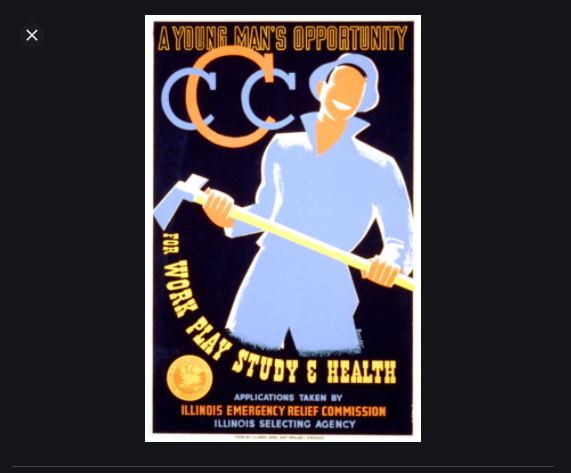OPINION: THE ANSWER IS ALL AROUND US. A NEW DEAL RESPONSE TO CORONAVIRUS

CCC poster. Illinois Emergency Relief Commission. Photo: Wikimedia Commons
Editor’s note: This column appeared previously in The Daily Hampshire Gazette

I haven’t walked this much in years. Working from home and desperate to get away from my gridded Zoom cell, I have found myself roaming my town, walking by the empty storefronts of downtown Amherst, and wandering through my University of Massachusetts campus.
I regularly pass by Goodell Hall, the university’s first major library building after it grew from the Massachusetts Agricultural College into the Massachusetts State College on its way to becoming the UMass in 1947. Goodell was built in 1935, one of the thousands of such projects undertaken by the federal Public Works Administration. Nearby is the university’s research administration center, built a few years later, also with PWA funds as part of the New Deal.
As I write this, I am looking forward to taking a quick drive over to Northampton to take a walk with a friend. To get there, I’ll cross over on the Calvin Coolidge Bridge, built with federal funds starting in 1936. Businesses were given contracts. Hundreds were put to work.
In nearby Holyoke, some of the unemployed found jobs through the Civilian Conservation Corps, building the paths and shelters at the state’s Mount Tom Reservation, while others repaired the canals that had made Holyoke the paper-making capital of the country and constructed the city’s War Memorial Building, the post office (including its glorious murals) and the high school football field stands. Still others fixed sidewalks and roads.
Almost every single city and town in Massachusetts, and across the country, was touched by New Deal investments. (You can look for yourself in the hours-occupying website livingnewdeal.org). If you have walked or driven on roads and bridges, or strolled through a state park, visited a post office, appreciated our historical monuments, gone to a zoo, taken the subway or flown from Logan Airport, you are the deserving beneficiary of investments made amid the worst economic crisis in the nation’s history, some 80 years ago.
The simple premise was this: People are out of work. There is work to be done. Let’s put the unemployed back to work. The goals were short-term — get people back to work, put money in their wallets and get the funds flowing through the economy — but the investments were for the long term.
Today we are victims — thousands and thousands of mortal victims — of an anti-government ideology that has taken over the Republican Party and a good swath of the Democratic one. We have failed to make fundamental investments in this nation for more than a generation.
If the coronavirus crisis tells us anything, it is that we desperately need robust federal investment, administered competently, to protect lives and prevent destitution for families in the short run. And we need it to ensure jobs and a more just economy in the long run.
While we need emergency investments to help the unemployed and to provide for health care and sick leave, we also need to use the opportunity to fix what has long ailed the United States: a failure to invest in the fundamental structures that make for a strong society — education, transportation and roads and bridges, to name a few examples. Moreover, we need it to achieve what the New Deal never did: create a true social welfare system that includes guarantees of health care and a quality education for all.
Already, we can hear the murmur of austerity talk — “belt-tightening,” “rough times ahead,” furloughs, budget cuts, retrenchment.
We must reject this way of thinking before it becomes a contagion. Let’s be clear: Austerity, like COVID-19, is bad for people, bad for our students, bad for educators, bad for public education, bad for our society and bad for our economy.
The news each day tempts us to fall into the austerity mindset. The papers tell us, for example, that unemployment might skyrocket to 25% in Massachusetts. This is catastrophic.
When have we have seen this before? During the Great Depression, of course.
After spending several years bungling a response to that crisis, FDR was forced to embrace a program of government spending designed to jumpstart the economy. The spending was massive, but it was focused well — on projects that protected the vulnerable and invested for the long term. Those kinds of investments, unlike the tax cuts for millionaires and giveaways to corporations to buy back their stock, did in fact pay for themselves.
In the Great Depression, the New Deal programs — producing so much of our essential physical environment — were the answers to the crisis. Those answers are all around us for us to see, and to use, and to learn from.
Max Page is Professor of Architecture and Director of Historic Preservation Initiatives at the University of Massachusetts Amherst and Vice President of the Massachusetts Teachers Association.
